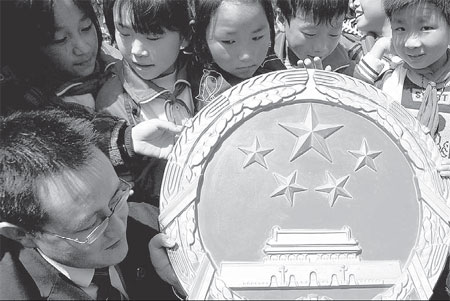Technology used to combat graft
Updated: 2013-02-26 08:05
By Cao Yin (China Daily)
|
||||||||
|
Judges tell primary school students in Dayang township, Chongqing, about the national emblem to help them establish awareness of the rule of law. Rao Guojun / for China Daily |
Academy's report on rule of law shows efforts by authorities
China has improved the way it deals with corruption and is increasingly using technology to combat graft, but experts say preventing the technology from being abused must also be taken into consideration.
The Chinese Academy of Social Sciences published a report on China's rule of law on Monday, which stated that the country's disciplinary authorities at every level have developed and applied technology to their anti-corruption work, such as online approval platforms and bribery record systems.
The report is published in the Blue Book on the Rule of Law, also produced by the academy.
In 2012, a system tracking companies and people who pay bribes was put into effect, which means prosecutors can check nationwide bribery information online, according to the report, adding that the country has made great progress on bribery prevention in this way.
The government in Hainan province developed an online system to prevent officials from intervening in administrative examination and approval, while Ningbo city's government, in Zhejiang province, also carried out electronic monitoring of administrations, the report said.
On Saturday, Party chief Xi Jinping stressed the promotion of the rule of law in an all-round manner, calling for scientific legislation, strict law enforcement, judicial justice and for every citizen to be beholden to the law.
Lu Yanbin, director of the academy's editorial office, said using technology to fight corruption has become increasingly effective and will continue to be explored this year.
Guangzhou, Guangdong province, is building a database that can integrate information from the city's authorities, such as the public security bureau, and tax and housing departments. The database will reveal any anomalies and help prevent corruption, the report said.
"Such technology is still just a beginning for the country," Lu said. "How to share the information on these systems and protect the database needs each department's cooperation."
Zhou Shuzhen, a professor of corruption research at Renmin University of China, spoke highly of the technology application on anti-graft work, saying several corrupt officials and cases were exposed by technology last year.
"The technology, to some extent, is a better platform to regulate procedures of every department, which can avoid officials who intend to take bribes or are corrupt through their work," Zhou said. "It is effective for disciplinary authorities to seek clues of corruption and provides a space for the public to supervise."
Meanwhile, these technical systems can help the public "see" and "feel" the government's anti-corruption work, according to Zhou, who said it is also a good way for people to understand Chinese authorities' determination to combat corruption.
However, she added that such technology is more useful in the earlier stages of anti-graft work and cannot be seen as the main way of solving the country's corruption problem.
Yang Xiaojun, a law professor at the Chinese Academy of Governance, echoed Zhou's comments, saying corruption will remain serious if those who are responsible for the technology cannot apply it well or abuse the system.
"After all, it is still people who control these systems and databases. If they make poor use of these online platforms after mastering the technology, the corruption may be more severe," Yang said.
Both experts said some current anti-corruption regulations are not practical and cannot work effectively.
"How to stimulate residents to supervise officials and make the regulations function should be key in the future," Yang added.
Hu Min, a researcher at the Chinese Academy of Governance, said now is the right time to make efforts to solve the graft problem by perfecting regulations and laws.
"We can't always say the work has a long way to go. Instead, we should learn from other countries and start the work right now," Hu said.
caoyin@chinadaily.com.cn
(China Daily 02/26/2013 page5)

 In Photos: 7.0-magnitude quake hits Sichuan
In Photos: 7.0-magnitude quake hits Sichuan
 Li Na on Time cover, makes influential 100 list
Li Na on Time cover, makes influential 100 list
 FBI releases photos of 2 Boston bombings suspects
FBI releases photos of 2 Boston bombings suspects
 World's wackiest hairstyles
World's wackiest hairstyles
 Sandstorms strike Northwest China
Sandstorms strike Northwest China
 Never-seen photos of Madonna on display
Never-seen photos of Madonna on display
 H7N9 outbreak linked to waterfowl migration
H7N9 outbreak linked to waterfowl migration
 Dozens feared dead in Texas plant blast
Dozens feared dead in Texas plant blast
Most Viewed
Editor's Picks

|

|

|

|

|

|
Today's Top News
Live report: 7.0-magnitude quake hits Sichuan, heavy casualties feared
Boston suspect cornered on boat
Cross-talk artist helps to spread the word
'Green' awareness levels drop in Beijing
Palace Museum spruces up
First couple on Time's list of most influential
H7N9 flu transmission studied
Trading channels 'need to broaden'
US Weekly

|

|








